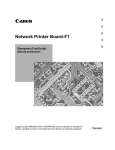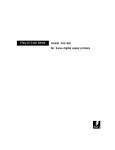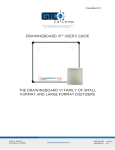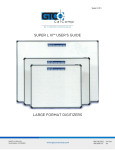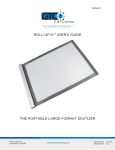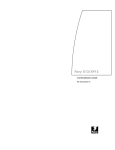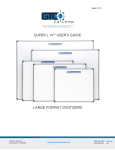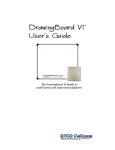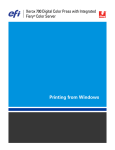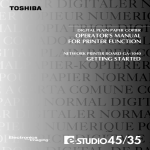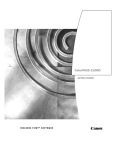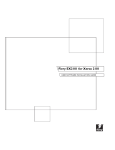Download Xerox 5750 All in One Printer User Manual
Transcript
DocuColor Color Server GETTING STARTED f o r t he X e r o x 5 7 5 0 digital copier printer Copyright © 1998 Electronics for Imaging, Inc. All rights reserved. This publication is protected by copyright, and all rights are reserved. No part of it may be reproduced or transmitted in any form or by any means for any purpose without express prior written consent from Electronics for Imaging, Inc., except as expressly permitted herein. Information in this document is subject to change without notice and does not represent a commitment on the part of Electronics for Imaging, Inc. The software described in this publication is furnished under license and may only be used or copied in accordance with the terms of such license. Patents: 5,666,436; 5,553,200; 5,543,940; 5,537,516; 5,517,334; 5,506,946; 5,424,754; 5,343,311; 5,212,546; 4,941,038; 4,837,722; 4,500,919. Trademarks Notice EFI, the EFI logo, Fiery, the Fiery logo, EFICOLOR and the EFICOLOR logo are trademarks registered in the U.S. Patent and Trademark Office. Fiery XJ, Fiery XJe, Fiery XJ+, Fiery SI, Fiery Driven, the Fiery Driven logo, XJ RipChips, Rip-While-Print, Continuous Print, Command WorkStation, AutoCal, STARR Compression, and Memory Multiplier are trademarks of Electronics for Imaging, Inc. Xerox 5760, 5765, 5790, 5750, MajestiK, Regal, and all Xerox product names mentioned in this publication are trademarks of the Xerox Corporation. Adobe, the Adobe logo, Adobe Illustrator, PostScript, Adobe Photoshop, Adobe Separator, and Adobe PageMaker, are registered trademarks of Adobe Systems Incorporated, registered in certain jurisdictions. EPS (Encapsulated PostScript) is a trademark of Altsys Corporation. Apple, the Apple logo, AppleShare, AppleTalk, EtherTalk, LaserWriter, and Macintosh are registered trademarks, and MultiFinder is a trademark of Apple Computer, Inc. Microsoft, MS, MS-DOS, and Windows are registered trademarks of Microsoft in the US and other countries. QuarkXPress is a registered trademark of Quark, Inc. Times, Helvetica, and Palatino are trademarks of Linotype AG and/or its subsidiaries. ITC Avant Garde, ITC Bookman, ITC Zapf Chancery, and ITC Zapf Dingbats are registered trademarks of International Typeface Corporation. Ethernet is a registered trademark of Xerox Corporation. Farallon, PhoneNET PC, and PhoneNET Talk are trademarks of Farallon Computing, Inc. COPS and COPSTalk are trademarks of CoOperative Printing Solutions, Inc. NetWare and Novell are registered trademarks and Internetwork Packet Exchange (IPX) is a trademark of Novell, Inc. SyQuest is a registered trademark, in the United States and certain other countries, of SyQuest Technology, Inc. UNIX is a registered trademark of UNIX System Laboratories, a wholly owned subsidiary of Novell, Inc. PANTONE is a registered trademark of Pantone, Inc. All other terms and product names may be trademarks or registered trademarks of their respective owners, and are hereby acknowledged. Legal Notices APPLE COMPUTER, INC. (“APPLE”) MAKES NO WARRANTIES, EXPRESS OR IMPLIED, INCLUDING WITHOUT LIMITATION THE IMPLIED WARRANTIES OF MERCHANTABILITY AND FITNESS FOR A PARTICULAR PURPOSE, REGARDING THE APPLE SOFTWARE. APPLE DOES NOT WARRANT, GUARANTEE, OR MAKE ANY REPRESENTATIONS REGARDING THE USE OR THE RESULTS OF THE USE OF THE APPLE SOFTWARE IN TERMS OF ITS CORRECTNESS, ACCURACY, RELIABILITY, CURRENTNESS, OR OTHERWISE. THE ENTIRE RISK AS TO THE RESULTS AND PERFORMANCE OF THE APPLE SOFTWARE IS ASSUMED BY YOU. THE EXCLUSION OF IMPLIED WARRANTIES IS NOT PERMITTED BY SOME STATES. THE ABOVE EXCLUSION MAY NOT APPLY TO YOU. IN NO EVENT WILL APPLE, ITS DIRECTORS, OFFICERS, EMPLOYEES OR AGENTS BE LIABLE TO YOU FOR ANY CONSEQUENTIAL, INCIDENTAL OR INDIRECT DAMAGES (INCLUDING DAMAGES FOR LOSS OF BUSINESS PROFITS, BUSINESS INTERRUPTION, LOSS OF BUSINESS INFORMATION, AND THE LIKE) ARISING OUT OF THE USE OR INABILITY TO USE THE APPLE SOFTWARE EVEN IF APPLE HAS BEEN ADVISED OF THE POSSIBILITY OF SUCH DAMAGES. BECAUSE SOME STATES DO NOT ALLOW THE EXCLUSION OR LIMITATION OF LIABILITY FOR CONSEQUENTIAL OR INCIDENTAL DAMAGES, THE ABOVE LIMITATIONS MAY NOT APPLY TO YOU. Apple’s liability to you for actual damages from any cause whatsoever, and regardless of the form of the action (whether in contract, tort [including negligence], product liability or otherwise), will be limited to $50. Restricted Rights Legends For defense agencies: Restricted Rights Legend. Use, reproduction, or disclosure is subject to restrictions set forth in subparagraph (c)(1)(ii) of the Rights in Technical Data and Computer Software clause at 252.227.7013. For civilian agencies: Restricted Rights Legend. Use, reproduction, or disclosure is subject to restrictions set forth in subparagraph (a) through (d) of the commercial Computer Software Restricted Rights clause at 52.227-19 and the limitations set forth in Electronics for Imaging, Inc.’s standard commercial agreement for this software. Unpublished rights reserved under the copyright laws of the United States. Part Number: n/a Printed in the United States of America on recycled paper. CE Mark The CE marking applied to this product symbolises Rank Xerox’s declaration of conformity with the following applicable directives of the European Union as of the dates indicated. January 1, 1996—Council Directive 70/80/CCO amended by Council Directive 93/68/EEO. Approximation of the laws of the member states related to low voltage equipment. January 1, 1996—Council Directive 59/336/EEC. Approximation of the laws of the member states related to electromagnetic compatibility. A full declaration defining the relevant directives and referenced standards can be obtained from your Rank Xerox representative. WARNING: In order to allow this equipment to operate in proximity to industrial, scientific, and Medical (ISM) equipment, the external radiation from ISM equipment may have to be limited or special migration measures taken. WARNING: This is a Class A product. In a domestic environment this product may cause radio interference, in which case the user may be required to take adequate measures. FCC Information WARNING: FCC Regulations state that any unauthorized changes or modifications to this equipment not expressly approved by the manufacturer could void the user’s authority to operate this equipment. NOTE: This equipment has been tested and found to comply with the limits for a Class A digital device, pursuant to Part 15 of the FCC Rules. These limits are designed to provide reasonable protection against harmful interference when the equipment is operated in a commercial environment. This equipment generates, and uses, and can radiate radio frequency energy and, if not installed and used in accordance with the instruction manual, may cause harmful interference to radio communications. Operation of this equipment in a residential area is likely to cause interference in which case the user will be required to correct the interference at his own expense. Industry Canada Class A Notice This digital apparatus does not exceed the Class A limits for radio noise emissions from digital apparatus as set out in the interference-causing equipment standard entitled, “Digital Apparatus” ICES-003 from Industry Canada. Avis de Conformation Classe A d l’Industrie Canada Le présent appareil numérique n’émet pas de bruits radioélectriques dépassant les limites applicables aux appareils numériques de la Classe A prescrites dans la norme sur le matériel brouilleur, “Appareils Numériques” NMB-003 édictée par l’Industrie Canada. Certificate by Manufacturer/Importer This is to certify that the FC07 is shielded against radio interference in accordance with the provisions of VFG 243/1991. The German Postal Services have been advised that this device is being put on the market and that they have been given the right to inspect the series for compliance with the regulations. Electronics for Imaging, Inc. Bescheinigung des Herstellers/Importeurs Heirmit wird bescheinigt, dass der FC07 im Uebereinstimmung mit den Bestimmungen der VFG 243/1991 Funk-Entstort ist. Der Deutschen Bundespost wurde das Inverkehrbringen dieses Geraetes angezeigt und die Berechtigung zur Ueberpruefung der Serie auf Einhaltung der Bestimmungen eingeraumt. Electronics for Imaging, Inc. RFI Compliance Notice This equipment has been tested concerning compliance with the relevant RFI protection requirements both individually and on system level (to simulate normal operation conditions). However, it is possible that these RFI Requirements are not met under certain unfavorable conditions in other installations. It is the user who is responsible for compliance of his particular installation. Dieses Geraet wurde einzeln sowohl als auch in einer Anlage, die einen normalen Anwendungsfall nachbildet, auf die Einhaltung der Funk-entstoerbestimmungen geprueft. Es ist jedoch moeglich, dass die Funk-enstoerbestimmungen unter unguenstigen Umstaenden bei anderen Geraetekombinationen nicht eingehalten werden. Fuer die Einhaltung der Funk-entstoerbestimmungen seigner gesamten Anlage, in der dieses Geraet betrieben wird, ist der Betreiber verantwortlich. Compliance with applicable regulations depends on the use of shielded cables. It is the user who is responsible for procuring the appropriate cables. Einhaltung mit betreffenden Bestimmungen kommt darauf an, dass geschirmte Ausfuhrungen gebraucht werden. Fuer die beschaffung richtiger Ausfuhrungen ist der Betreiber verantwortlich. Software License Agreement Electronics for Imaging, Inc. grants to you a non-exclusive, non-transferable license to use the software and accompanying documentation (“Software”) included with the DocuColor Color Server you have purchased, including without limitation the PostScript® software provided by Adobe Systems Incorporated. You may: a. use the Software solely for your own customary business purposes and solely with DocuColor; b. use the digitally-encoded machine-readable outline and bitmap programs (“Font Programs”) provided with DocuColor in a special encrypted format (“Coded Font Programs”) to reproduce and display designs, styles, weights, and versions of letters, numerals, characters and symbols (“Typefaces”) solely for your own customary business purposes on the screen of the DocuColor or Macintosh monitor used with DocuColor; c. use the trademarks used by Electronics for Imaging to identify the Coded Font Programs and Typefaces reproduced therefrom (“Trademarks”); and d. assign your rights under this Agreement to a transferee of all of your right, title and interest in and to DocuColor provided the transferee agrees to be bound by all of the terms and conditions of this Agreement. You may not: a. make use of the Software, directly or indirectly, to print bitmap images with print resolutions of 600 dots per inch or greater, or to generate fonts or typefaces for use other than with DocuColor; b. make or have made, or permit to be made, any copies of the Software, Coded Font Programs, accompanying documentation or portions thereof, except as necessary for use with the DocuColor unit purchased by you; provided, however, that under no circumstances may you make or have made, or permit to be made, any copies of that certain portion of the Software which has been included on the DocuColor hard disk drive. You may not copy the documentation; c. attempt to alter, disassemble, decrypt or reverse engineer the Software, Coded Font Programs or accompanying documentation. d. rent or lease the Software. Proprietary Rights You acknowledge that the Software, Coded Font Programs, Typefaces, Trademarks and accompanying documentation are proprietary to Electronics for Imaging and its suppliers and that title and other intellectual property rights therein remain with Electronics for Imaging and its suppliers. Except as stated above, this Agreement does not grant you any right to patents, copyrights, trade secrets, trademarks (whether registered or unregistered), or any other rights, franchises or licenses in respect of the Software, Coded Font Programs, Typefaces, Trademarks or accompanying documentation. You may not adapt or use any trademark or trade name which is likely to be similar to or confusing with that of Electronics for Imaging or any of its suppliers or take any other action which impairs or reduces the trademark rights of Electronics for Imaging or its suppliers. The trademarks may only be used to identify printed output produced by the Coded Font Programs. At the reasonable request of Electronics for Imaging, you must supply samples of any Typeface identified with a trademark. The MacApp software is proprietary to Apple Computer, Inc. and is licensed to Electronics for Imaging, Inc. for distribution only for use in combination with DocuColor software utilities. Confidentiality You agree to hold the Software and Coded Font Programs in confidence, disclosing the Software and Coded Font Programs only to authorized users having a need to use the Software and Coded Font Programs as permitted by this Agreement and to take all reasonable precautions to prevent disclosure to other parties. Remedies Unauthorized use, copying or disclosure of the Software, Coded Font Programs, Typefaces, Trademarks or accompanying documentation will result in automatic termination of this license and will make available to Electronics for Imaging other legal remedies. Limited Warranty And Disclaimer Electronics for Imaging warrants that, for a period of ninety (90) days from the date of delivery to you, the Software under normal use will perform without significant errors that make it unusable. Electronics for Imaging’s entire liability and your exclusive remedy under this warranty (which is subject to you returning DocuColor to Electronics for Imaging or an authorized dealer) will be, at Electronics for Imaging’s option, to use reasonable commercial efforts to attempt to correct or work around errors, to replace the Software with functionally equivalent software, or to refund the purchase price and terminate this Agreement. Some states do not allow limitations on duration of implied warranty, so the above limitation may not apply to you. Except for the above express limited warranty, Electronics for Imaging makes and you receive no warranties or conditions on the Products, express, implied, or statutory, and Electronics for Imaging specifically disclaims any implied warranty or condition of merchantability or fitness for a particular purpose. For warranty service, please contact your authorized service/support center. EXCEPT FOR THE ABOVE EXPRESS LIMITED WARRANTY, ELECTRONICS FOR IMAGING MAKES AND YOU RECEIVE NO WARRANTIES OR CONDITIONS ON THE SOFTWARE OR CODED FONT PROGRAMS, EXPRESS, IMPLIED, STATUTORY, OR IN ANY OTHER PROVISION OF THIS AGREEMENT OR COMMUNICATION WITH YOU, AND ELECTRONICS FOR IMAGING SPECIFICALLY DISCLAIMS ANY IMPLIED WARRANTY OR CONDITION OF MERCHANTABILITY OR FITNESS FOR A PARTICULAR PURPOSE. Electronics for Imaging does not warrant that the operation of the software will be uninterrupted or error free or that the Software will meet your specific requirements. Limitation Of Liability IN NO EVENT WILL ELECTRONICS FOR IMAGING OR ITS SUPPLIERS BE LIABLE FOR ANY DAMAGES, INCLUDING LOSS OF DATA, LOST PROFITS, COST OF COVER OR OTHER SPECIAL, INCIDENTAL, CONSEQUENTIAL OR INDIRECT DAMAGES ARISING FROM THE USE OF THE SOFTWARE, CODED FONT PROGRAMS OR ACCOMPANYING DOCUMENTATION, HOWEVER CAUSED AND ON ANY THEORY OF LIABILITY. THIS LIMITATION WILL APPLY EVEN IF ELECTRONICS FOR IMAGING OR ANY AUTHORIZED DEALER HAS BEEN ADVISED OF THE POSSIBILITY OF SUCH DAMAGE. YOU ACKNOWLEDGE THAT THE PRICE OF DOCUCOLOR XJ REFLECTS THIS ALLOCATION OF RISK. BECAUSE SOME STATES/JURISDICTIONS DO NOT ALLOW THE EXCLUSION OR LIMITATION OF LIABILITY FOR CONSEQUENTIAL OR INCIDENTAL DAMAGES, THE ABOVE LIMITATION MAY NOT APPLY TO YOU. Export Controls You agree that you will not export or re-export the Software or Coded Font Programs in any form without the appropriate United States and foreign government licenses. Your failure to comply with this provision is a material breach of this Agreement. Government Use Use, duplication or disclosure of the Software by the United States Government is subject to restrictions as set forth in subdivision (c) (1) (ii) of the Rights in Technical Data and Computer Software clause at DFARS 252.227-7013 or in subparagraphs (c) (1) and (2) of the Commercial Computer Software—Restricted Right Clause at 48 CFR 52.227-19, as applicable. Third Party Beneficiary You are hereby notified that Adobe Systems Incorporated, a California corporation located at 345 Park Ave., San Jose, CA 95110 (“Adobe”) is a third-party beneficiary to this Agreement to the extent that this Agreement contains provisions which relate to your use of the Fonts, the Coded Font Programs, the Typefaces and the Trademarks licensed hereby. Such provisions are made expressly for the benefit of Adobe and are enforceable by Adobe in addition to Electronics for Imaging. General This Agreement will be governed by the laws of the State of California. This Agreement is the entire agreement held between us and supersedes any other communications or advertising with respect to the Software, Coded Font Programs and accompanying documentation. If any provision of this Agreement is held invalid, the remainder of this Agreement shall continue in full force and effect. If you have any questions concerning this Agreement, please write to Electronics for Imaging, Inc., Attn: Licensing Dept. or see Electronics for Imaging’s web site at www.efi.com. Electronics for Imaging, Inc. 2855 Campus Drive San Mateo, CA 94403 Contents Introduction About the media pack ix About the documentation ix System requirements for Macintosh users x System requirements for Windows users x Networking requirements xi System requirements for UNIX users xi User software xii Setting up printing from a Macintosh computer Verifying the network 1 Installing the printer driver 1 Setting up the DocuColor in the Chooser 2 Installing user software on a Windows computer Installation overview 3 Installing Windows utilities 4 Configuring the Chooser list for Windows 95 and Windows NT 4.0 7 Setting up the DocuColor as a PostScript printer 15 Setting up printing with Windows 3.1x 15 Setting up printing with Windows 95 20 Setting up printing with Windows NT 3.51 33 Setting up printing with Windows NT 4.0 38 Copying the PPD for Adobe PageMaker 49 viii Table of Contents WebTools Setting up the WebTools 51 Using the WebTools Installer 52 Troubleshooting On a Macintosh computer 55 On a Windows computer 55 Index ix Introduction About the media pack This manual describes how to install the user software for the DocuColor Color Server™ and set up printing from Macintosh and Windows computers. For information on setting up network servers and clients to use the DocuColor, see the Administrator Guide. For general information on using the color copier, your computer, your application software, or your network, see the manuals that accompany those products. About the media pack Your DocuColor includes a media pack containing: • User Software CD—printer drivers and files you can install directly onto Macintosh and Windows computers, plus utilities for Windows computers • Documentation set About the documentation This manual is part of a set, which also includes the following manuals for users and system administrators: • The User Guide describes how to set printing options and print to the DocuColor. This manual describes how to use the software installed from the CD. It includes sections on printing from Macintosh and Windows computers and UNIX workstations. • The Administrator Guide explains basic configuration and administration of the DocuColor for the supported platforms and network environments. It also includes guidelines for setting up UNIX, Windows NT, and NetWare servers to provide PostScript printing services to clients. • Release Notes provide last-minute product information and workarounds for some of the problems you may encounter. x Introduction System requirements for Macintosh users For installation of user software, you need a CD-ROM drive. This can be either an internal CD-ROM drive in your computer or an external drive with the appropriate cable and software to run on your computer. To use the DocuColor with a Macintosh computer, you need: • Any Macintosh computer in the Macintosh II, Quadra, Centris, Performa, or Power Macintosh families that has at least 4MB of RAM and EtherTalk® Phase 2 installed • Apple System software version 7.0 or later • Adobe® PostScript® Printer Driver version 8.0 or later, or Apple® LaserWriter® driver version 7.0 or later; and PPD (PostScript Printer Description) files (The current version of the Adobe PostScript Printer Driver and the PPD files are included with the DocuColor User Software.) • To print to the DocuColor from a Macintosh computer, you need a Novell network and AppleTalk print services loaded on the server. System requirements for Windows users For installation of user software, you need a CD-ROM drive. This can be either an internal CD-ROM drive in your computer or an external drive with the appropriate cable and software to run on your computer. To use the DocuColor with a Windows computer, you need: • A Windows computer with an 80386, 80486, or Pentium processor and at least 4MB of RAM • A mouse that is supported by Windows • MS-DOS version 5.0 or later • Microsoft® Windows version 3.1 or later, Windows 95, Windows NT 3.51, or 4.0 • To print to the DocuColor from Windows, you need to use a PostScript printer driver and PostScript Printer Description (PPD) file. These drivers and PPD files are included with the User Software. Use the Adobe PostScript Printer Driver for Windows version 3.0.1 with Windows 3.1x. Use version 4.2 with Windows 95. xi System requirements for UNIX users • To print from computers running Windows NT 3.51 or 4.0, you can use the PostScript driver delivered with the operating system, and the DocuColor PPD file provided with the User Software. Networking requirements For network use with Windows 3.1x, you need: • SPX/IPX protocol (Novell), Ethernet, or Token Ring For network use with Windows 95, you need: • TCP/IP networking protocol or SPX/IPX networking protocol (Novell) For network use with Windows NT, you need TCP/IP networking protocol IPX (Novell) • With an IPX (Novell) network, you need a Novell file server running NetWare software version 3.11 or later that supports Frame Ethernet 802.3 or 802.2, or Ethernet II. System requirements for UNIX users To use the DocuColor with a UNIX workstation, you need: • Workstations with Standard TCP/IP Ethernet connectivity supporting the lpr protocol in compliance with RFC 1179 • TCP/IP printing software that conforms to RFC1179 (Berkeley lpr protocol) xii Introduction User software The User Software CD includes: Downloader™ Enables you to print PostScript and Encapsulated PostScript files directly to the DocuColor without using the application in which they were created. The Downloader also enables you to manage the printer fonts installed on the DocuColor. Spooler™ Enables you to view the order and priority of print jobs, customize printer settings for jobs, delete jobs, and move jobs between queues. You can also use it to view job accounting information. Adobe PostScript Enables you to print to the DocuColor and supports the features Printer Driver of PostScript Level 2 and later. Printer Files Printer description files for popular applications that require them in order for the DocuColor to appear in the application’s Print and Page Setup dialog boxes. The DocuColor printer description files provide information about the DocuColor to applications and printer drivers. 1 Verifying the network ‘The general steps for setting up printing from a Macintosh computer are: Setting up printing from a Macintosh computer • Verify the network is configured for IPX printing. • Install the Adobe PostScript Printer Driver (version 8.5.1 supports PostScript 3). • Set up the DocuColor in the Chooser. Verifying the network Verify that your system administrator has set up the network for IPX printing as described in the Administrator Guide. Printing from Macintosh computers is supported only for IPX networks. Installing the printer driver Printer drivers provide a way to communicate information on print jobs between your applications and the DocuColor (and any other PostScript printer connected to your computer). TO INSTALL THE PRINTER DRIVER : 1. Open the Printer Driver folder on the User Software CD. 2. Double-click the AdobePS 8.5 Installer icon. 3. Click OK in the welcome screen. 4. Click Install in the dialog box that appears. This installs the Adobe PostScript Printer Driver, the printer description files that correspond to your copier, and the Apple Chooser 7.3 (if you are using an earlier version). 5. Click OK in the dialog box informing you that installation is complete. 2 Setting up printing from a Macintosh computer If you operate the DocuColor in a copy shop, quick print shop, or service bureau, you might want to provide copies of the printer driver, printer description files, and relevant documentation to customers. This ensures that jobs they create and print to files are properly formatted for printing to the DocuColor. Setting up the DocuColor in the Chooser After you install the printer driver and printer description files, you need to set up the DocuColor in the Chooser in order to take full advantage of its features. This section describes how to set up the DocuColor with the Adobe PostScript Printer Driver. TO SET UP THE D OCU C OLOR IN THE C HOOSER : 1. Select Chooser from the Apple menu. 2. Click the AdobePS icon. 3. Select the correct AppleTalk zone if necessary. 4. Select the name of your DocuColor. 5. Click Setup, and click Select PPD. 6. Choose the correct printer description file for your DocuColor, and click Select. 7. Close the Chooser. 3 Installing user software on a Windows computer Installation overview This chapter describes installing utilities for computers running Windows 95 and Windows NT 4.0, and setting up printing for Windows 3.1x, Windows 95, Windows NT 3.51, and Windows NT 4.0. Installation overview N OTE : You may have to install or configure other programs or files before you can install the user software. The general steps for installing the DocuColor user software are: • Install the utilities (Downloader and Spooler) using the Installer. • If you will be using the utilities with Windows 95 or Windows NT 4.0 over an IPX/SPX or TCP/IP network, configure the Chooser list. (This is sometimes done by your system administrator.) • Install the Adobe PostScript Printer Driver. • Set up the printer driver to communicate with the DocuColor. • If you will be using Adobe Pagemaker, move the printer description file to the appropriate location. 4 Installing user software on a Windows computer Installing Windows utilities The Software Installer installs Downloader and Spooler. TO INSTALL UTILITIES : 1. Insert the User Software CD in your computer. 2. In the NT File Manager, double-click the icon for the CD-ROM to display its contents. If you have Windows 95, open the My Computer window and double-click the icon for the CD drive. 3. Double-click to open the following folders: ENGLISH\INSTALLR\DISK1. 4. Double-click the SETUP icon. 5. Click Next in the Welcome dialog box. 5 Installing Windows utilities 6. In the Software dialog box, select Utilities and click Next. 7. Specify the name of the Program Folder in which to install the utilities, or click Next to use the default name. 6 8. Installing user software on a Windows computer Specify the network type. Select IPX/SPX if you are using Windows 95; select TCP/IP if you are using Windows NT. N OTE : The network protocol you choose here will become the default when you configure the utilities. If you choose TCP/IP (the default) and your network protocol is IPX/SPX, you need to do two things after the installation: delete the NET_WSCK.DLL file from the System folder in your active Windows folder, and re-install the utilities, this time choosing IPX/SPX in the Network dialog box. 9. Verify the information in the Start Copying Files dialog box and then click Next. The files are copied to your hard disk. 7 10. Installing Windows utilities If you are prompted, browse to the location of the NET_WSCK.INI file that has been customized for your site. If you do not have a customized NET_WSCK.INI file, you can use the default file. If you use the default file, make sure that you configure the Chooser list before you try to use the utilities. See “Configuring the Chooser list for Windows 95 and Windows NT 4.0” on page 7 for instructions. 11. Click OK when you are informed that installation is complete. Configuring the Chooser list for Windows 95 and Windows NT 4.0 If you are using Windows 95 with an IPX/SPX network, or using Windows NT 4.0 with a TCP/IP network, you must configure the Chooser list for your server. N OTE : You should re-configure this file whenever there is a change to your DocuColor server or network that affects the information in the file. TO PREPARE TO EDIT THE • C HOOSER LIST : If you are using IPX/SPX, print the Configuration page from the Control Panel to determine the IPX address and server name. In general, you should use the Ethernet IPX address. If you are connected through a Token Ring network, use the Token Ring IPX address. 8 • Installing user software on a Windows computer If you are using TCP/IP, set up a Domain Name Server (DNS) for the IP address of the DocuColor in the printcap file. If your network does not support DNS servers, edit the HOSTS file in your WINDOWS directory and insert an IP address for the DocuColor. (See your system documentation for information.) Then go to page 11, “To configure the Chooser list for TCP/IP networks:” for TCP/IP instructions. TO CONFIGURE THE C HOOSER LIST FOR IPX/SPX NETWORKS : 1. Start any of the utilities (Downloader or Spooler). 2. When the following dialog box appears, click OK. 9 3. Installing Windows utilities In the Add New Server dialog box, enter a Server Name. The Server Name is indicated in the Server Setup section of the Configuration page. The server name is the name you entered for Server Name on the DocuColor Control Panel if you are using IPX/SPX (Windows 95). 4. Enter the IPX Address. The IPX address is indicated in the Network Setup section of the Configuration page. N OTE : The IPX address is a unique value associated with the DocuColor hardware and Novell server connection and cannot be changed. 5. Enter the Device name for your copier in the New Device box For a 5750 copier, enter 5750 This device name appears in the Printer Setup section of the Configuration page. 10 6. Installing user software on a Windows computer When you have entered all the information, click Add. The device appears in the Devices list. 11 7. Installing Windows utilities Click OK. The server appears in the Chooser list of available servers. 8. To end the configuration process and begin using the utility, click OK. N OTE : Configuring the Chooser list also customizes the NET_WSCK.INI configuration file in your active Windows folder. This file is now ready to be copied to a floppy disk. You can insert the floppy disk containing the customized NET_WSCK.INI file when you install the utilities on other workstations that will be used for printing to the DocuColor (see step 10, page 7). If you want to make changes to this configuration, or if you want to add another configuration, click Configure. See “Setting up the DocuColor as a PostScript printer” on page 15 to continue the installation process. TO CONFIGURE THE C HOOSER LIST FOR TCP/IP NETWORKS : 1. Start up any of the utilities (Downloader or Spooler). 2. Click OK when the following message appears. 12 3. Installing user software on a Windows computer In the Add New Server dialog box, enter a DNS Name (or IP address) and a device name in the New Device box. The server name is either the DNS name or the IP address for a DocuColor server when you are using TCP/IP with Windows NT. The Server Name is indicated in the Server Setup section of the Configuration page. The IP address is indicated in the Network Setup section of the Configuration page. The New Device name for a 5750 copier is 5750. This device name appears in the Printer Setup section of the Configuration page. 13 4. Installing Windows utilities When you have entered all the information, click Add. The device appears in the Devices list. 14 5. Installing user software on a Windows computer Click OK. The server appears in the Chooser list of available servers. 6. To end the configuration process and begin using the utility, click OK. N OTE : Configuring the Chooser list also customizes the NET_WSCK.INI configuration file in your active Windows folder. This file is now ready to be copied to a floppy disk. You can insert the floppy disk containing the customized NET_WSCK.INI file when you install the utilities on other workstations that will be used for printing to the DocuColor (see step 10, page 7). If you want to make changes to this configuration, or if you want to add another configuration, click Configure and go through the appropriate steps. See “Setting up the DocuColor as a PostScript printer” on page 15 to continue the installation process. 15 Installing Windows utilities Setting up the DocuColor as a PostScript printer To set up the DocuColor as a PostScript printer, you need a PostScript printer driver and the appropriate DocuColor printer description files. Printer drivers and procedures vary across Windows versions. These sections also include some information about network setup. Consult the section that applies to your version of Windows. • See “Setting up printing with Windows 3.1x” on page 15. • See “Setting up printing with Windows 95” on page 20. • See “Setting up printing with Windows NT 3.51” on page 33. • See “Setting up printing with Windows NT 4.0” on page 38. Setting up printing with Windows 3.1x To take advantage of PostScript Level 2 features in applications that support them, install the Adobe PostScript Printer Driver (version 3.0.1 included with User Software CD). T O INSTALL THE A DOBE P OST S CRIPT W INDOWS 3.1 X : PRINTER DRIVER AND PPD FOR USE WITH 1. Start Windows and exit any applications that start automatically. 2. Insert the User Software CD in your computer. 3. In the Windows Program manager, choose Run from the File menu. 4. Click Browse. 5. Select the drive containing your User Software CD or Printer Files disk, open the ENGLISH\PRNTDRV\WIN_31 folders, and select the SETUP.EXE file. 6. Click OK in the Browse and Run dialog boxes. 7. Follow the on-screen instructions. 16 8. Installing user software on a Windows computer Once the printer driver has been installed, click Restart to restart Windows. The Adobe PostScript Printers dialog box appears when Windows restarts. If you do not see it, double-click the Adobe PostScript Printers icon in the Windows Program Manager Control Panel. 9. Select the DocuColor printer file that corresponds to your device. 10. Click Install. 11. Click OK when you are notified that installation was successful. 12. Click Close when installation is complete. Setting the default printer with Windows 3.1x You can specify the DocuColor as the default printer. Many Windows applications use the default printer when you choose the Print command. TO SET THE DEFAULT PRINTER : 1. In the Control Panel window, double-click the Printers icon. The Printers window appears. 2. In the Printers window, select your DocuColor in the Installed Printers list box. 17 3. Installing Windows utilities Click Set As Default Printer. The DocuColor appears in the Default Printer area of the Printers window. Selecting a printer port with Windows 3.1x When you install a printer, Windows assigns it to a default printer port. If the DocuColor is connected to your computer through a network or you want to assign it to a different port, you need to change the port assignment. For information on which port to use, see your system administrator. You can use this procedure to enable printing with the parallel port. TO SELECT A PRINTER PORT : 1. In the Control Panel window, double-click the Printers icon. 2. In the Printers window, select the DocuColor in the Installed Printers list box. 3. Click Connect. The Connect window appears. 18 4. Installing user software on a Windows computer Connect the DocuColor to the same port as your network. For parallel printing, select the port (LPT1, LPT2, or LPT3) connected to your parallel cable. To print to a file, select FILE. Printing to a file is useful if the DocuColor is off-site. However, if you select the FILE port, you cannot print to a printer until you select a network or printer port. (In some applications, you can select the FILE port from the Print dialog box; this is preferable for temporary use since it doesn’t require resetting the port in the Control Panel.) 5. Click OK. The Printers window appears again, with the selected port next to the highlighted printer name in the Installed Printers list box. 6. When you are finished, click OK and then click Close. Setting up IPX (Novell) printing with Windows 3.1x TO SET UP IPX (N OVELL ) PRINTING FOR WINDOWS : 1. In the Main group of the Windows Program Manager, double-click the Windows Setup icon. 2. Choose Change System Settings from the Options menu. Double-click here 19 Installing Windows utilities 3. From the Network menu, choose Novell NetWare (shell version 3.26 and above) or (shell version 4.0 and above). 4. Click OK. When prompted, restart Windows. 5. In the Main group, double-click Control Panel, and then double-click Printers. 6. In the Printers Control Panel window, click Connect to connect the printer to the appropriate port. 7. Select Network. If you are printing to a file, select FILE. Printing to a file is useful if the printer is elsewhere. However, if you select the FILE port, you cannot print to a printer until you select a network or printer port. If you select Network, the next window depends on the NetWare client driver version. 8. If the Network Printer Connections dialog box is displayed, select the port in the Printer connections box. 20 9. 10. Installing user software on a Windows computer In the Available queues list box, select the server and queue name that correspond to the printer. Click the Connect button and then click the Close button. The Connect dialog box is displayed with the network path to the printer. 11. Click OK in the Connect dialog box. 12. Click Close in the Printers dialog box. 13. Click OK. The Printers window appears again, with the selected port next to the highlighted printer name in the Installed Printers list box. You or your network administrator should verify the network connection by printing a test document from each networked computer that will use the printer. If you use PageMaker, continue to “Copying the PPD for Adobe PageMaker” on page 49 for information on specific file locations on your computer. Setting up printing with Windows 95 You can print to the printer from your Windows 95 workstation in several ways. First, you need to install the Adobe PostScript Printer Driver for Windows (included with the user software) and the printer description file (PPD) on your computer. Next, you set up the printer to accept your print jobs via one of the following connections: • parallel port • IPX (Novell) network • Windows printing 21 Installing Windows utilities T O INSTALL THE D OCU C OLOR WITH THE A DOBE P OST S CRIPT P RINTER D RIVER AND W INDOWS 95: 1. Print a copy of the Configuration page for your DocuColor. This will help you through the installation process. Before you run the Adobe installer, you should know whether you are installing a network or local printer; if it is a network printer, you need to know the path or queue name of the printer. 2. In the Windows 95 Explorer, select the User Software CD, select the ENGLISH\PRNTDRV\WIN_95 folder, and double-click the SETUP.EXE icon. SETUP.EXE is the filename for the Adobe Installer. 3. Continue the installation procedure and follow the on-screen instructions. 4. When installation is complete, click Add Another or Exit. Completing the Windows 95 parallel port connection Preparing a parallel port connection for Windows 95 requires specific BIOS settings on your computer, and specific port and printer settings for Windows 95. In addition, a change to the DocuColor Setup may be required if you choose to spool files to the DocuColor rather than print directly. TO PREPARE THE D OCU C OLOR AND YOUR COMPUTER FOR PARALLEL PORT PRINTING : 1. Connect the DocuColor to the parallel port on your computer. For instructions, see the Administrator Guide. 2. To spool files to the DocuColor, set the DocuColor Setup option for Port Timeout in Seconds to 10 seconds. The default setting for this option is 5 seconds, which is not adequate for spooling. Setting this option to 10 seconds ensures that spooling is not interrupted due to timeout. The Port Timeout in Seconds option is accessed from the Network Setup section of Setup. You can change this Setup option from the Control Panel or from the Command WorkStation. An Administrator password may be required to access Setup. For instructions, see the Administrator Guide. 22 Installing user software on a Windows computer To print directly to the printer, you can use the default setting of 5 seconds. 3. In your computer’s BIOS settings, set Parallel Port Mode to Compatible. To access the BIOS settings, restart the computer and press the key indicated on your monitor as soon as the computer starts up. You may have to scroll through several screens to reach the parallel port settings. After setting the Parallel Port Mode to Compatible, save your changed setting and exit. TO PREPARE THE PRINTER FOR PARALLEL PORT PRINTING : 1. Click the Start button, point to Settings, and click Printers. 2. Click the DocuColor printer icon and choose Properties from the File menu. 3. Click the Details tab and make sure the box “Print to the following port:” reads exactly as follows: LPT 1: (Printer Port). N OTE : Check this box carefully. It may read LPT 1: (ECP Printer Port), which is not equivalent to LPT 1: (Printer Port). If this box does not read LPT 1: (Printer Port), change the port setting now, as described in “To prepare the port for parallel port printing:” on page 24, and then return to this procedure. You may need your Windows 95 system CD. 23 Installing Windows utilities 4. Click Spool Settings. 5. Select Disable bi-directional support for this printer. 6. Select either Spool print jobs so program finishes printing faster or Print directly to the printer. The choice you make here depends on the action you took in step 2 of “To prepare the DocuColor and your computer for parallel port printing:” on page 21. If you set the port timeout in Setup to 10 seconds, you can select either option, but spooling will be faster. If you left the port timeout at its default, select Print directly to the printer. 7. Click OK. 8. Click Apply and click OK. You are now ready to print from your applications to the DocuColor with the parallel port. To confirm the connection, print a Windows 95 test page. 24 9. 10. Installing user software on a Windows computer Click the General tab in the Properties dialog box. Click Print Test Page and click OK. N OTE : You need to perform the following procedure only if the LPT 1 port is not currently set to Printer Port. TO PREPARE THE PORT FOR PARALLEL PORT PRINTING : 1. From the Windows 95 desktop, click the Start button, point to Settings, and click Control Panel. 2. Double-click System. The System Properties window appears. 25 Installing Windows utilities 3. Click the Device Manager tab. 4. Double-click Ports and then double-click the LPT1 port. 26 Installing user software on a Windows computer 5. In the LPT1 port Properties dialog box, click the Driver tab and then click Change Driver. 6. Select Show all devices. 27 Installing Windows utilities 7. From the list of manufacturers, select (Standard port types). From the list of Models, select Printer Port (not ECP Printer Port). Click OK. 8. Click OK in the LPT1 port Properties dialog box. N OTE : You might need to insert the Windows 95 system CD to complete this step depending on whether the required files are on your hard disk. 9. 10. Click Close in the System Properties dialog box. Restart the computer. After Windows 95 restarts, you can complete the procedure described in “To prepare the printer for parallel port printing:” on page 22. Completing the Windows 95 IPX/SPX or IPX (Novell) connection If you are printing through a Novell server, before you begin, the Novell network and file server should be set up. The file server should be configured with a print server and print queue for the printer. For details see your NetWare documentation and the Administrator Guide. Without a Novell server, you can use the utilities with IPX/SPX to download and manage jobs. You cannot print from Windows 95 applications over IPX/SPX without a Novell server. 28 TO SET UP Installing user software on a Windows computer IPX/SPX PRINTING : 1. Open the Windows 95 Control Panel. 2. Double-click the Network icon. 3. Make sure that IPX/SPX-compatible Protocol and TCP/IP protocol are both listed in the Installed Network Components section. See your Windows 95 documentation for instructions. N OTE : You must enable TCP/IP printing to ensure that all files required for IPX/SPX will be installed. You can select it and click Remove after you set up IPX/SPX if you do not need to use the TCP/IP protocol. 4. Double-click the IPX/SPX-compatible Protocol icon. 5. Click Advanced. 29 6. Installing Windows utilities In the Property list, click Frame Type and select the Frame Type that corresponds to the one set during DocuColor Control Panel Setup. Print the Configuration page from the Control Panel to see the Frame Type if necessary. N OTE : Do not select Auto, this may not select the Frame Type specified on the DocuColor. 7. Click OK and close the Network Control Panel. 30 TO SET UP Installing user software on a Windows computer IPX (N OVELL ) PRINTING WITH W INDOWS 95: 1. Click the Start button, point to Settings, and then click Printers. 2. Click the icon for the printer and choose Properties from the File menu. 3. Click the Details tab in the Properties window and click Add Port. A list of connection options is displayed. 4. In the Add Port dialog box, specify the network path, or click Browse for a display of your network environment. 5. If you are using a NetWare file server, double-click the icon of the NetWare file server you want to use for printing to the printer and click OK. 6. Click the printer icon labeled with the NetWare print queue you will use and click OK. 7. In the Add Port dialog box, verify that the network path is updated and click OK. You are ready to print from the workstation. Your print jobs will be transmitted to the specified print queue on the Novell file server. The printer will poll the file server, and if jobs are present, they will be transmitted to the DocuColor. 8. To confirm the connection, you can print a Windows 95 test page. Click the General tab in the Properties dialog box. 9. Click Print Test Page. 10. Click OK. Completing the Windows printing connection If you don’t have a Novell network, you can print via Windows printing, also known as SMB or WINS printing. Printing by this method allows you to print from your computer to a particular queue (Print or Direct) on the DocuColor. Check with your network administrator to determine whether this type of connection is appropriate for your network environment. You might need to specify additional settings. For example, if your computer and the DocuColor are on different subnets, you might need to enable WINS resolution and specify a WINS Name Server. 31 Installing Windows utilities To set up printing to a second queue, you must install a new printer for each queue and repeat the following procedures. Give each printer a descriptive name during printer driver installation, such as Astro-Print or Astro-Direct, so you can easily identify printers. B EFORE YOU BEGIN : 1. Verify the DocuColor has been configured for Windows printing in Network Setup > Service Setup > Windows Setup. For more information, see the Administrator Guide. 2. Print a DocuColor Configuration page. You need information from the Configuration page to specify settings on your computer, such as the Server Name and IP address of the WINS Name Server (if applicable). TO SET UP W INDOWS PRINTING : 1. From the Windows 95 Start menu, choose Settings, and click Printers. 2. Click the icon for the printer and choose Properties from the File menu. 3. Click the Details tab in the Properties window and click Add Port. 4. In the Add Port dialog box, click Network, and click Browse to display your network environment. 32 5. Installing user software on a Windows computer Expand the levels to locate your printer and the queue you want to print to. The printer name you are browsing for is the WINS Name Server. Refer to the Configuration page for this information. The amount of network traffic determines the amount of time required for the Browse function. 6. Select the queue under the printer and click OK. 7. In the Add Port dialog box, verify that the network path is correct and click OK. 8. To confirm the connection, click the General tab in the Properties dialog box. 9. Click Print Test Page and click OK. If the Test Page prints successfully, you are ready to print from the computer. 33 Installing Windows utilities Setting up printing with Windows NT 3.51 To set up Windows NT printing, install the Windows NT PostScript printer driver and configure printing for your network type. Note that printer files support the Intel version of Windows NT. If your administrator has set up the DocuColor on an NT server and shared it, you may not have to enter all the information described in this section. Any windows that are not necessary will not appear, and you can verify information that appears in other windows instead of typing in new information. For information about setting up and printing to the DocuColor with a Windows NT server, see the Administrator Guide. N OTE : If you have problems installing the DocuColor with Windows NT, try installing another PostScript printer (such as the Apple LaserWriter IIg), and then install the DocuColor. Installing another printer insures that all files are properly installed and available. For instructions, see your Windows NT documentation. TO INSTALL THE PRINTER FILE FOR A PARALLEL , TCP/IP, OR CONNECTION FROM W INDOWS NT W ORKSTATION : A PPLE T ALK 1. In the Windows NT Print Manager window, choose Create Printer from the Printer menu. 2. In the Create Printer dialog box, scroll down the list of drivers and select Other. The Install Driver dialog box is displayed, prompting you to insert the disk. 34 3. Installing user software on a Windows computer Browse the User Software CD to find \ENGLISH\PRNTDRV\WIN_NT3X. The Select Driver dialog box displays the name of the printer(s) for which there are printer description files on the disk. 4. Select the printer description file for your device and click OK. 5. In the Windows NT Setup dialog box, enter the path to your PostScript drivers, and then click Continue. If you have already installed a PostScript printer, and the Windows NT system is on your c: drive, type the following path: c:\winnt35\system32\spool\drivers\w32x86 If you have not already installed a PostScript printer, you will be prompted to insert your Windows NT system software CD or floppy disks. In that case, if the CD-ROM drive with your system CD is the d: drive, type the path: d:\i386 35 6. Installing Windows utilities Enter a name for the DocuColor in the Printer Name box in the Create Printer dialog box, and then click OK. The DocuColor model name is displayed in the Driver box. 7. When the PostScript Printer Setup dialog box appears, click OK. Even though the printer does not use halftoning, do not uncheck Use Printer Halftoning. The printer now appears in its own Printer window in the Print Manager window. 36 Installing user software on a Windows computer 8. In the Print Manager toolbar, select the printer as the Default printer. 9. Copy the printer description file and then connect the printer to a port or a network connection. Print Manager window Server window Completing the Windows NT Workstation printer setup TO SET UP PARALLEL PRINTING FOR 1. W INDOWS NT W ORKSTATION : Double-click the printer icon in the Print Manager window and choose Properties from the Printer menu. In the Printer Properties dialog box, confirm that LPT1 appears in the “Print to” box. 2. Click Details to check and configure the defaults. Since parallel port jobs are spooled on the printer, select Print Directly to Ports to bypass Windows NT Print Manager spooling. Click OK. 3. Click OK to exit the Printer Details dialog box. The printer is ready to accept parallel print jobs from your computer, using the Windows NT PostScript printer driver and the copier printer description file. When you select Print, your PostScript files will be transmitted over the parallel port connection to the Print queue. The network administrator should verify the parallel port connection by printing a simple document to LPT1, the designated port. 37 Installing Windows utilities T O SET UP TCP/IP W ORKSTATION : AND LPR PRINTING FOR W INDOWS NT 1. In the Main group, double-click the Print Manager icon. 2. With the DocuColor window active, choose Properties from the Printer menu. 3. In the Print to list, scroll to Other. The Print Destinations dialog box is displayed. 4. Select LPR Port and click OK. This option is available if you installed TCP/IP with the LPR printing protocol when you installed Windows NT. See your Windows NT documentation for information. 5. In the “Add LPR compatible printer” dialog box, enter the IP address or hostname of the DocuColor in the Name or address region. You can print the Configuration page to see the IP address. 6. In the Name of printer area, type the internal name of the printer in lowercase letters: queue_devicename. N OTE : This name must exactly match print_5750. 7. Click OK. The Printer Properties dialog box shows the printer printing to IP Address:QueueName 38 Installing user software on a Windows computer 8. Enter or verify the name of the printer in the Printer Name box in the Create Printer dialog, and then click OK. 9. Click OK. You have configured your workstation to use TCP/IP to communicate with the printer. When you select Print, your PostScript files will be transmitted over the LPR Port connection to the queue set up on the server by your administrator. To verify the connection, print a test document from each networked computer that will use the printer. Setting up printing with Windows NT 4.0 Before you can set up PostScript printing for Windows NT 4.0, you need to install the Windows NT PostScript printer driver. The following procedures describe how to install the PostScript Printer Description file (PPD) for your printer and how to configure printing for your network type. The printer files provided on the User Software CD support the Intel version of Windows NT. There is more than one possible sequence of steps in installing the same printer. To avoid presenting an excessively branching procedure, we suggest that you install the DocuColor as a local parallel port printer first, and add the network port connection after the driver installation. If you prefer, you can install the network port first and the driver later. Adding a printer to a local system requires that you log in to your local Windows NT workstation (not the network server domain) and that you are a member of the Administrators group for your workstation. If your Windows NT computer is a client on a network, and you want to print to a shared printer, find out the name of the server on which the printer is defined. TO SET UP P OST S CRIPT PRINTING WITH W INDOWS NT 4.0: 1. Insert the User Software CD into your computer. 2. Click Start in the Windows NT taskbar, choose Settings, and then choose Printers. 39 3. Installing Windows utilities Double-click Add Printer. “My Computer” is available if you logged in to a computer on which you have Administrator privileges. If it is not available, you can add a network printer. The procedure is similar to adding a port (see page 45). 4. To install a printer locally, select My Computer, and click Next. The available system ports are displayed. 5. Check LPT1: and click Next. This is a general installation that works for the parallel port connection. You can add a network port later, according to your network type. 40 6. Installing user software on a Windows computer In the dialog box displaying lists of manufacturers and printers, click Have Disk. The Install From Disk dialog box prompts you for the disk. 7. Type the name of the CD-ROM drive (for example, D:\) and click Browse. 8. In the Locate File dialog box, browse to the ENGLISH\PRNTDRV\WIN_NT4X folder and click Open. Make sure Ntprint.inf is selected and appears in the File name field. 41 Installing Windows utilities The path is copied to the Install From Disk dialog box. 9. Click OK to install the DocuColor PPDs from the path you chose. 10. In the list of printers, select the file that corresponds to your printer and click Next. 11. Enter a name for the DocuColor, or leave the default name, and choose whether you want the DocuColor to be your default printer. Click Next. 12. Indicate whether to install the printer as a shared printer. Click Next. 13. Click No in the next dialog box to postpone printing a test page, and click Finish. 14. If the Files Needed dialog box appears, locate the Windows NT PostScript driver PSCRIPT.DLL. If you have a PSCRIPT.DLL file on your hard drive, it probably resides in winnt\system32\spool\drivers\w32x86. 42 Installing user software on a Windows computer If this is the first PostScript printer installed on your system, you may need to eject the User Software CD and insert the Windows NT Installation CD to locate a PSCRIPT.DLL file. The path on the Windows CD is \i386. 15. Click OK, then click OK in the Files Needed dialog box. When installation is complete, the Printers window appears with an icon for the newly installed printer. 16. Right-click the DocuColor icon, and choose Properties. 43 Installing Windows utilities 17. Select the appropriate options, and click OK. 18. Complete the printer connection, according to your network type. • To configure the parallel connection, see “Completing the Windows NT 4.0 parallel port connection” on page 43. • To configure the TCP/IP (Lpr port) connection, see “Completing the Windows NT 4.0 TCP/IP connection” on page 44. • To configure the IPX (Novell) connection, see “Completing the Windows NT 4.0 IPX (Novell) connection” on page 47. Completing the Windows NT 4.0 parallel port connection The parallel port cable connects the DocuColor to a single computer. TO SET UP PARALLEL PRINTING FOR W INDOWS NT 4.0: 1. Click the Start button, choose Settings, and then choose Printers. 2. Double-click the DocuColor icon, and choose Properties from the Printer menu. In the Ports property sheet, confirm that LPT1 (Local Port) is checked. The DocuColor is ready to accept parallel print jobs from your computer. 3. Select the General property sheet, and click Print Test Page. When you select Print, your files are transmitted over the parallel port connection to the DocuColor. 4. Select the Sharing property sheet if you want to share the printer with network users. Select Shared, and select a share name. Select the operating system or systems used by your network clients if you want to install a printer driver that those clients can download. 5. Click OK to exit the Printer Properties dialog box. 44 Installing user software on a Windows computer Completing the Windows NT 4.0 TCP/IP connection Complete the setup for the TCP/IP and lpr connection as follows: • Prepare the DocuColor to accept print jobs using TCP/IP and lpr protocols. • Configure the workstation for the TCP/IP connection. Before you continue, ask the system administrator for the IP address assigned to the DocuColor, as well as the subnet mask and the gateway address, if they are used. T O PREPARE THE D OCU C OLOR LPR PRINTING : FOR TCP/IP AND 1. With the DocuColor turned off, connect it to the network. 2. Turn on the DocuColor and from the Control Panel, select PRINTER SETUP. Confirm that one of the queues is enabled. 3. Select NETWORK SETUP. Enable TCP/IP and enter the appropriate settings for IP address, subnet mask and gateway address. For details, see the Administrator Guide. 4. Exit NETWORK SETUP and save changes. The DocuColor reboots. The TCP/IP Protocol and Microsoft TCP/IP printing services must already be installed on the Windows NT workstation. 45 TO SET UP Installing Windows utilities TCP/IP AND LPR PRINTING FOR W INDOWS NT 4.0: 1. Open the Printer Properties dialog box for the DocuColor. Click Ports to display the Ports property sheet. 2. Click Add Port. The available port types are displayed. 3. Select LPR Port and click New Port. If the LPR port is not listed, install the TCP/IP protocols. See the Administrator Guide or your Windows NT documentation. 46 4. Installing user software on a Windows computer In the “Add LPR compatible printer” dialog box, enter the IP address of the DocuColor. If your network uses Domain Name Services (DNS), enter the DNS name assigned to the DocuColor instead of the IP address. 5. Press Tab and type the internal name of the DocuColor in lowercase letters. The name must be print_5750. N OTE : Type this name exactly as shown; it is required for communication with the DocuColor. 6. Click OK. The workstation checks the address or DNS name that you entered and notifies you if it cannot resolve the address. 7. Close the Printer Ports dialog box. The Ports property sheet shows the new port configuration. 8. Click OK to close the Ports property sheet. The new port has been configured. You should now print a test page to verify the connection. 9. Open the Printer Properties dialog box for the DocuColor. Click General and click Print Test Page. When you print, your files are transmitted over the LPR Port connection to the DocuColor. 10. Click OK to exit the Printer Properties dialog box. 47 Installing Windows utilities Completing the Windows NT 4.0 IPX (Novell) connection Complete the setup for the IPX (Novell) connection as follows: • Configure the Novell network and file server for handling DocuColor print jobs. The file server should be configured with a print server and print connection for the DocuColor. For details, see your NetWare documentation. • Prepare the DocuColor for IPX printing. • Set up the IPX connection on the workstation. TO SET UP IPX (N OVELL ) PRINTING WITH W INDOWS NT 4.0: NetWare protocols (NWLink IPX/SPX Compatible Transport) and NetWare client services should already be installed on the Windows NT workstation. 1. Double-click Network Neighborhood. 2. Double-click NetWare or Compatible Network. A list of NetWare servers is displayed. 3. Double-click the NetWare Tree or File Server on which the network administrator defined a print connection for the DocuColor. You may have to log in to the file server as guest to see the print connections. 48 4. Installing user software on a Windows computer Double-click the print connection defined for the DocuColor. If the NetWare server does not have a suitable driver for the DocuColor you may be asked if you want to set up the printer on your workstation. 5. Click Yes. You see the Add Printer Wizard. 6. “Install” the PPD just as you did before (see page 40); the driver is already installed on your system. 7. When installation is complete, a new printer window appears, with the name of the print queue on the NetWare server. 8. Choose Properties from the Printer menu. Click Ports. 9. The NetWare queue you just connected to is listed and checked as a port for the DocuColor. 49 10. Copying the PPD for Adobe PageMaker Click the General property sheet and click Print Test Page. The DocuColor polls the NetWare server for print jobs in the print connection defined for the DocuColor. When you print, your PostScript files are spooled to that connection and transmitted over the queue “port” to the DocuColor. The test page job is listed in the queue window until it is printed. Copying the PPD for Adobe PageMaker If you use Adobe PageMaker, you should copy the PostScript Printer Description file (PPD) to a specific location in your PageMaker directory. TO COPY THE PRINTER DESCRIPTION FILES FROM THE CD: 1. Insert the User Software CD in your computer. 2. Open the ENGLISH\PRNTDRV directory. 3. Open the directory for your Windows system. 4. Copy the printer description file for your DocuColor to the appropriate location. If you use: PageMaker 5.0 or later Copy this file: EFSIX503.PPD To this location: For PageMaker 5.0, \ALDUS\USENGLSH\PPD4 For PageMaker 6.0, \PM6\RSRC\USENGLSH\PPD4 51 Setting up the WebTools The WebTools allow you to manage the DocuColor remotely from the Internet or from your company’s intranet. The DocuColor has its own home page, from which you can select from a variety of functions including Status, WebSpooler, WebLink, and Installer. WebTools For more information on managing the DocuColor with the WebTools, see the User Guide. Setting up the WebTools In order for network users to access and use the WebTools, you need to set options in Network Setup and Printer Setup on the DocuColor Control Panel. You also need to prepare each user’s workstation to communicate with the DocuColor over the Internet or intranet. N OTE : With the exception of a Java-enabled browser as described in this section, you do not need to install software to use the WebTools because they are already installed on the DocuColor. TO SET UP W EB T OOLS ON THE D OCU C OLOR : 1. On the DocuColor Control Panel, access Setup. 2. In Printer Setup, set “Publish Print Queue” to Yes. 3. Exit Printer Setup, and select Yes at the Save Changes screen. 52 TO SET UP WebTools W EB T OOLS ON EACH USER ’ S WORKSTATION : 1. Enable TCP/IP networking. 2. Make sure the workstation has a valid, unique IP address. 3. Make sure the workstation is installed with one of the following Internet browsers: Windows 95 and Windows NT—Netscape Communicator v4.0.2 or Microsoft Internet Explorer v3.0.2 Mac OS—Netscape Communicator v4.0.1 N OTE : The WebTools are not supported with any version of Netscape Navigator. 4. Make sure Java is enabled in your Internet browser. For more information on setting up the DocuColor and your network, see the Administrator Guide. Using the WebTools Installer The WebTools Installer provides the same printer driver installer as found on the User Software CD, allowing you to easily download the current version of the printer driver from the DocuColor to your workstation. TO INSTALL THE PRINTER DRIVER FROM THE W EB T OOLS I NSTALLER : 1. Launch your Internet or intranet browser and enter the DNS name or IP address of the DocuColor. 2. Click the Installer button. The Installer window appears. 53 3. Using the WebTools Installer Under the name of your operating system, click “Printer Files”. For Windows computers, a dialog box appears, prompting you to save the file “Prntdrve.exe” to the location you choose. For Mac OS computers, a folder named “Printer Driver” is downloaded to the desktop in a BinHex-encoded, compressed format. If your internet browser is equipped with an expander utility such as StuffIt Expander™, the folder will be decoded and decompressed automatically. 4. For Windows computers, browse to the location where you want to save the Prntdrve.exe file and click Save. For Mac OS computers, if the Printer Driver folder was not automatically decoded and decompressed, launch a utility that will perform that function. 5. For Windows computers, double-click the Prntdrve.exe file, browse to the location where you want to install the Prnt_drv folder, and click Next. For instructions on installing the PostScript printer driver for Windows 95, see page 20; for Windows 3.1x, see page 15; for Windows NT 4.0, see page 38; for Windows NT 3.51, see page 33. 55 On a Macintosh computer This section provides some suggestions in case you encounter problems while installing and setting up software. Troubleshooting On a Macintosh computer Installing Macintosh PostScript Printer Driver • If the Printer Driver cannot autoselect the printer file, when prompted, open the System Folder:Extensions:Printer Descriptions folder and select the file that corresponds to your copier. On a Windows computer Setting up IPX (Novell) printing for Windows NT Workstation • Install the Apple LaserWriter IIg before you attempt to “add a printer” for the DocuColor. Installing Adobe PostScript Printer Driver If you are re-installing the Adobe PostScript Printer Driver, you must delete any previous versions and related files from DOS before you can successfully install the driver. See the Adobe README file included with the Printer Driver for instructions. Problems with Windows and IPX/SPX • If you are using Windows 95, make sure that SPX/IPX and TCP/IP networking protocols are both enabled. See “Completing the Windows 95 IPX/SPX or IPX (Novell) connection” on page 27 for information. • Make sure that either the NET_WIPX.DLL(Windows 95) or NET_WSCK.DLL (Windows NT) file is in the SYSTEM directory. Make sure that only one file is installed in this directory and that it is the correct file for your system. 56 Troubleshooting • Make sure that the NET_WSCK.INI file is in the WINDOWS directory. • Open the NET_WSCK.INI file with a text editor and make sure that it is customized correctly for your site. Index A Adobe PageMaker for Windows 49 Adobe PostScript printer driver Macintosh, troubleshooting 55 Windows 3.1x 15 Windows 95 21 ADOBEPS.DRV see Adobe PostScript printer driver C Chooser list, configuring 7 to 14 connecting Macintosh Chooser 2 Windows 3.1x by IPX (Novell) 18 Windows 3.1x by parallel port 18 Windows 95 by IPX 28 Windows 95 by parallel port 24 Windows 95 by Windows printing 30 Windows NT 3.51 by parallel port 36 Windows NT 3.51 by TCP/IP 37 Windows NT 4.0 by parallel port 43 Windows NT 4.0 by TCP/IP 44 D device name 9, 12 Windows NT 3.51 with TCP/IP 37 Windows NT 4.0 with TCP/IP 46 Downloader, installing 4 F Frame Type, IPX for Windows 95 29 I installing utilities Windows 95 4 Windows NT 4.0 4 internal name Windows NT 3.51 with TCP/IP 37 Windows NT 4.0 with TCP/IP 46 IPX (Novell) Windows 3.1x printing 18 Windows 95 28, 30 IPX address 9 L LaserWriter driver x LPR Windows NT 3.51 37 Windows NT 4.0 44 M Macintosh system requirements x N NetWare network port with Windows 3.1x 19 network port with Windows 95 30 NetWare client setup Windows 3.1x 18 Windows 95 28, 30 Novell (IPX) see IPX (Novell) P parallel port Windows 3.1x 18 Windows 95 22, 24 Windows NT 3.51 36 Windows NT 4.0 43 PostScript printer driver Windows NT 4.0 38 printer description files Windows 49 I-2 Index S SMB printing 30 Spooler, installing 4 system requirements Macintosh x Windows x T TCP/IP Windows NT 3.51 37 Windows NT 4.0 44 U utilities installing for Windows 95 and NT 4.0 4 W WebTools Installer 52 installing the printer driver from 52 setting up 51 Windows system requirements x Windows 3.1x Adobe PostScript printer driver 15 parallel port 18 Windows 95 Adobe PostScript printer driver 21 connecting to parallel port 24 connecting via Windows printing 30 installing utilities 4 IPX/SPX 28 Windows NT 3.51 parallel port 36 PostScript printer driver 33 TCP/IP 37 Windows NT 4.0 device name 46 installing utilities 4 parallel port 43 PostScript printer driver 38 setting up printing 38 to 49 TCP/IP 44 WINS Name Server 32 WINS printing 30







































































